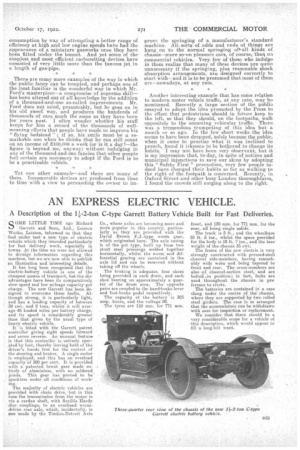AN EXPRESS ELECTRIC VEHICLE.
Page 25

If you've noticed an error in this article please click here to report it so we can fix it.
A Description of the 11-2-ton C-type Garrett Battery Vehicle Built for Fast Deliveries.
OIVIE LITTLE TIME ago Richard Garrett and Sons, Ltd., Leiston Works, Leiston, informed us that they had under testa new type of electric vehicle which they intended particularly for fast delivery week, especially in towns. At the time we were not allowed to divulge information regarding this machine, but we are now able to publish an illustration and interesting details. It has long been recognized that the electric-battery vehicle is one .of the cheapest means of transport, but the disadvantages have been its comparatively slow speed and low mileage capacity per charge. The new Garrett has been designed to overconne these faults. Although strong, it is particularly light, and has a loading capacity of between 30 cwt. and 2 tons, whilst it will average 45 loaded miles per battery charge, and its speed is considerably greater than that given by the usual type of heavy electric vehicle.
It is fitted with the Garrett patent controller giving eight speeds forward and seven reverse. An unusual feature is that this controller is entirely operated by foot, thereby leaving both of the driver's hands free for the control of the steering and brakes. A single motor is employed, and this has an overload capacity of 300 Per cent. It is provided with a patented brush gear made entirely of aluminium, with no soldered joints. This gear has proved to be' sparkless under all conditions of working.
The majority of electric vehicles are provided with chain drive, but in this case the transmission from the motor is via a cardan shaft, with flexible Hardy disc couplings, to an overhead wormdriven rear axle, which, incidentally, is one made by the Timken-Detroit Axle Co., whose axles are becoming more and more popular in this country, particularly as they are provided with the David Brown F.J.-type worm gear, which originated here. The axle casing is of the pot type, built up from two Stout steel pressings welded together horizontally, whilst the worm and differential gearing are contained in the axle lid and can be removed without taking off the wheels.
The braking is adequate, four shoes being provided in each drum and each shoe hearing on approximately a quarter of the drum area. The opposite pairs are coupled to the hand-brake lever and foot-brake pedal respectively.
The capacity of the battery is 305 amp. hours, and the voltage 88.
The tyres are 110 mm. for 771 MM.
front, and 120 mm. for 771 mm. fox the rear, all being single solids.
The track is 5 ft., and the wheelbase 10 ft. 5 ins., whilst the space provided for the body is 10 ft. 7 ins., and the tare weight of the chassis 35 cwt.
The frame of the new electric is very strongly constructed with pressed-steel channel side-members, having remarkably wide webs and being tapered to front and rear. The cross-members are also of channel-section steel, and are bolted .in . position; in fact, bolts are used I throughout the chassis in preference to rivets.
The batteries are contained in a case slung under the centre of the' chassis, *here they are supported by two rolled steel girders. The case is so arranged that the accumulators can be withdrawn with ease for inspection or replacement.
We consider that there should be a very considerable scope for a vehicle of this description, which would appear to fill a long-felt want.
































